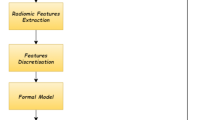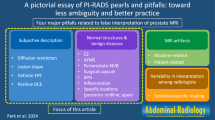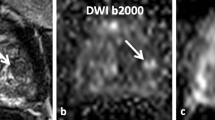Abstract
Introduction and objectives
The Prostate Imaging Reporting and Data System (PI-RADS) version 2 emerged as standard in prostate magnetic resonance imaging examination. The Pi-RADS scores are assigned by radiologists and indicate the likelihood of a clinically significant cancer. The aim of this paper is to propose a methodology to automatically mark a magnetic resonance imaging with its related PI-RADS.
Materials and methods
We collected a dataset from two different institutions composed by DWI ADC MRI for 91 patients marked by expert radiologists with different PI-RADS score. A formal model is generated starting from a prostate magnetic resonance imaging, and a set of properties related to the different PI-RADS scores are formulated with the help of expert radiologists and pathologists.
Results
Our methodology relies on the adoption of formal methods and radiomic features, and in the experimental analysis, we obtain a specificity and sensitivity equal to 1.Q
Conclusions
The proposed methodology is able to assign the PI-RADS score by analyzing prostate magnetic resonance imaging with a very high accuracy.




Similar content being viewed by others
References
Matthias R, Blondin D, Schlemmer HP, Franiel T (2013) Pi-rads classification: structured reporting for mri of the prostate. Rofo 185(3):253–261
Barentsz JO, Weinreb JC, Verma S, Thoeny HC, Tempany CM, Shtern F, Padhani AR, Margolis D, Macura KJ, Haider MA et al (2016) Synopsis of the pi-rads v2 guidelines for multiparametric prostate magnetic resonance imaging and recommendations for use. Eur Urol 69(1):41
Fusco R, Sansone M, Petrillo A (2017) A comparison of fitting algorithms for diffusion-weighted mri data analysis using an intravoxel incoherent motion model. Magn Reson Mater Phys, Biol Med 30(2):113–120
Hamoen Esther HJ, de Rooij M, Witjes JA, Barentsz JO, Rovers MM (2015) Use of the prostate imaging reporting and data system (pi-rads) for prostate cancer detection with multiparametric magnetic resonance imaging: a diagnostic meta-analysis. Eur Urol 67(6):1112–1121
Tristan B, Baris T, Choyke Peter L (2015) Pi-rads version 2: what you need to know. Clin Radiol 70(11):1165–1176
Roberta F, Mario S, Vincenza G, Venanzio SS, Antonella P (2017) A systematic review on multiparametric mr imaging in prostate cancer detection. Infect Agents Cancer 12(1):1–14
Sansone M, Fusco R, Petrillo A (2019) D-optimal design of b-values for precise intra-voxel incoherent motion imaging. Biomed Phys Eng Express 5(3):035025
Roberta F, Vincenza G, Mauro MR, Paolo V, Pasquale DRA, Claudio S, Maurizio DB, Antonella P, Mario S (2021) Blood oxygenation level dependent magnetic resonance imaging (mri), dynamic contrast enhanced mri and diffusion weighted mri for benign and malignant breast cancer discrimination: A preliminary experience. Cancers 13(10):2421
Yoon PS, Chul JD, Taik OY, Hoon CN, Deuk CY, Ho RK, Joon HS, Kyunghwa H (2016) Prostate cancer: Pi-rads version 2 helps preoperatively predict clinically significant cancers. Radiology 280(1):108–116
Schoots Ivo G (2018) Mri in early prostate cancer detection: how to manage indeterminate or equivocal pi-rads 3 lesions? Transl Androl Urol 7(1):70
Brunese L, Mercaldo F, Reginelli A, Santone A (2019) Neural networks for lung cancer detection through radiomic features. In: 2019 international joint conference on neural networks (IJCNN), pp 1–10. IEEE
Till-Alexander H, Sherko K, Angela K, Hamami Monia E, Steffen H, Anton Q, Andreas B, Michael F, Thomas L, Gerald A et al (2010) Diagnostic value of diffusion-weighted magnetic resonance imaging (dwi) compared to fdg pet/ct for whole-body breast cancer staging. Eur J Nucl Med Mol Imag 37(6):1077–1086
Iima M, Partridge SC, Le Bihan D (2020) Six dwi questions you always wanted to know but were afraid to ask: clinical relevance for breast diffusion mri. European Radiology, Springer, pp 1–10
Kumar Virendra G, Yuhua BS, Anders B, Eschrich Steven A, Schabath Matthew B, Kenneth F, Aerts Hugo JWL, Andre D, David F et al (2012) Radiomics: the process and the challenges. Magn Reson Imag 30(9):1234–1248
Stirling C (1989) An introduction to modal and temporal logics for CCS. UK/Japan Workshop on Concurrency, Springer, pp 1–20
Brunese L, Mercaldo F, Reginelli A, Santone A (2020) Formal methods for prostate cancer gleason score and treatment prediction using radiomic biomarkers. Magn Reson Imaging 66:165–175
Brunese L, Mercaldo F, Reginelli A, Santone A (2019) Prostate gleason score detection and cancer treatment through real-time formal verification. IEEE Access 7:186236–186246
Milner R (1989) Communication and concurrency. PHI Series in computer science. Prentice Hall
Cleaveland R, Li T, Sims S (2000) The concurrency workbench of the new century, version 1.2-user’s manual
Leonardo R, Changhee H, Yudai N, Jin Z, Ryuichiro H, Carmelo M, Andrea T, Nobile Marco S, Claudio F, Daniela B et al (2019) Use-net: incorporating squeeze-and-excitation blocks into u-net for prostate zonal segmentation of multi-institutional mri datasets. Neurocomputing 365:31–43
Tyler C, Junjie Z, Sameer B, Alexander W, Haider MA, Khalvati F (2017) Fully automated segmentation of prostate whole gland and transition zone in diffusion-weighted mri using convolutional neural networks. J Med Imag 4(4):041307
Lapa P, Castelli M, Gonçalves I, Sala E, Rundo L (2020) A hybrid end-to-end approach integrating conditional random fields into cnns for prostate cancer detection on mri. Appl Sci 10(1):338
Wang Z, Liu C, Cheng D, Wang L, Yang X, Cheng K-T (2018) Automated detection of clinically significant prostate cancer in mp-mri images based on an end-to-end deep neural network. IEEE Trans Med Imag 37(5):1127–1139
Patrick S, Simon K, Philipp RJ, Manuel W, Philipp K, Sebastian B, Anselm KT, Albrecht S, Markus H, Heinz-Peter S et al (2019) Classification of cancer at prostate mri: deep learning versus clinical pi-rads assessment. Radiology 293(3):607–617
Wang J, Chen-Jiang W, Bao M-L, Zhang J, Wang X-N, Zhang Y-D (2017) Machine learning-based analysis of mr radiomics can help to improve the diagnostic performance of pi-rads v2 in clinically relevant prostate cancer. Eur Radiol 27(10):4082–4090
David B, Simon K, Manuel W, Patrick S, Philipp RJ, Michael G, Philipp K, Kaneschka Y, Bertram H, Nils G et al (2018) Radiomic machine learning for characterization of prostate lesions with mri: comparison to adc values. Radiology 289(1):128–137
Chen T, Li M, Gu Y, Zhang Y, Yang S, Wei C, Wu J, Li X, Zhao W, Shen J (2019) Prostate cancer differentiation and aggressiveness: assessment with a radiomic-based model vs. pi-rads v2. J Magn Reson Imag 49(3):875–884
Author information
Authors and Affiliations
Corresponding author
Ethics declarations
Conflict of interest
The authors declare that there is no conflict of interest. This research involves human participants. The informed consent was obtained from all participants to the study.
Additional information
Publisher's Note
Springer Nature remains neutral with regard to jurisdictional claims in published maps and institutional affiliations.
Rights and permissions
About this article
Cite this article
Brunese, L., Brunese, M.C., Carbone, M. et al. Automatic PI-RADS assignment by means of formal methods. Radiol med 127, 83–89 (2022). https://doi.org/10.1007/s11547-021-01431-y
Received:
Accepted:
Published:
Issue Date:
DOI: https://doi.org/10.1007/s11547-021-01431-y




